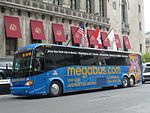- Motor Coach Industries
-
Motor Coach Industries 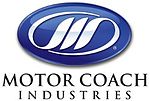
Type Private company Industry Transportation Founded 1933 Headquarters Schaumburg, Illinois, United States Products Buses and Coaches Owner(s) KPS Capital Partners Employees 2,300 Website Motor Coach Industries Motor Coach Industries International Inc. (MCII) is an American bus manufacturer based in Schaumburg, Illinois, and is a leading participant in the North American coach bus industry. It has various operating subsidiaries:
- Motor Coach Industries, Ltd. – Canadian manufacturing facility, located in Winnipeg, Manitoba.
- Motor Coach Industries, Inc. – U.S. manufacturing facility, located in Pembina, North Dakota.
- MCI Sales & Service, Inc. – U.S. new and pre-owned coach sales division.
- MCI Service Parts – aftermarket parts sales division of the company, based in Schaumburg, Illinois, with its distribution center located in Louisville, Kentucky, with close access to the international UPS distribution center.
- MCI Financial Services – coach financing division, based in Dallas, Texas.
Originally founded in 1933 in Winnipeg, Manitoba, Canada, in 2008 the company filed for Chapter 11 bankruptcy protection. After various changes of structure and ownership, the business is now owned by KPS Capital Partners, LP; in September 2010 they completed a controlling investment, through an affiliate, in MCII Holdings Inc., the parent company of MCII.
Contents
History
The company was incorporated in 1933 as Fort Garry Motor Body and Paint Works Limited, in Winnipeg, Manitoba, Canada by Harry Zoltok.[1] In 1948, Greyhound Lines of Canada, at that time MCI's major customer, became a majority shareholder when it purchased 65% of the company. MCI was purchased outright by Greyhound Lines in 1958. In 1962 a new plant was opened in Pembina, North Dakota to increase capacity as Greyhound widened its markets and switched increasingly from GMC to its own in-house products. In 1974 another plant was opened in Roswell, New Mexico under the title Transportation Manufacturing Corporation (TMC).[citation needed]
In December 1986, Greyhound was split, with Greyhound Lines being sold to an investor group, and Greyhound Lines of Canada, MCI and TMC remaining part of The Greyhound Corporation, which was renamed Dial, Inc. in 1991.
In 1987, Greyhound Corporation bought the transit bus manufacturing operations of General Motors Diesel Division (GMC), which was based in Canada. (GM phased out intercity and transit bus construction at the large GMC Coach and Truck plant in Pontiac, Michigan, shifting medium duty school bus chassis production to Janesville, Wisconsin.)[citation needed]
MCI also took over production of GM's RTS model, transferring production to TMC. MCI also purchased the GM bus assembly plant in Saint-Eustache, Quebec, which then produced GM's Canadian transit bus model, the Classic. TMC ceased production of the older MCI vehicles in 1990 to concentrate on manufacturing the RTS, and on the "A-Model" intercity coaches.[citation needed]
In 1993 MCI became an independent corporation, Motor Coach Industries International Inc.[citation needed]
In 1994, MCI stocks where purchased by Mexican DINA S.A.,[2][3] who had a long history of bus building and developed their HTQ proprietary technology[4][5][6] (valued in a total of 70 million dollars)[7] that culminated with the creation of the Viaggio Confort Bus Line. Over the course of the next years MCI reproduced its Viaggio 1000 DOT for sale to the U.S and Canada. In late 1999/2000 the G4100, G4500 and F3500 models were released to the U.S. and Canadian markets. Production of the G4100 and G4500 later moved to Winnipeg and Pembina. Related to a major contract cancellation[8] by Western Star[9] DINA S.A. sold a great portion of its previously acquired MCI shares to Joseph Littlejohn & Levy.[10]
In 1994 TMC, including production rights for the RTS, was sold to NovaBus .
After a period of product demand, increased competition and lay-offs in the early 2000s, production at MCI plants in Winnipeg and Pembina increased in 2006, and 130 employees were added.
During the late 1999s and early 2000s, MCI consolidated its operations, the Winnipeg site was expanded and modernized as well as DINA S.A. purchased North American Symix[11] and opened an assembly plant[12] in Buenos Aires Argentina[13] and the DIMEX[14] and DINAIR companies.[15] A new coach finishing and paint facility and customer delivery centre were constructed on the site. At the same time, a 7-year contract was attained with the IAMAW union local. This agreement contained cost improvements and production operations flexibility to improve the productivity and competitiveness of the manufacturing and assembly operations.
The buses, especially the older MC-8 and workhorse MC-9 models of the 1980s became the standard for interstate travel for many bus companies. Those particular buses featured metal frames and roof supports, metal panels on the sides and were extremely durable and reliable. Many of the buses, having survived millions of miles of commercial use, have been given a second career serving churches or other organizations, while the MCI/TMC coaches are very popular "conversion shells," used for motorhomes.
Currently, the "J" and "D" models are the leading coaches in the North American intercity coach market.
2008 Emergence from Chapter 11 Bankruptcy / Ownership by KPS Capital Partners, LP
Motor Coach Industries Inc. announced on September 15, 2008, the company had filed for Chapter 11 bankruptcy protection as part of a restructuring the company said would "help shed hundreds of millions of dollars of debt."[16]
On Friday, April 17, 2009, Motor Coach Industries Inc. emerged from its voluntary Chapter 11 reorganization. MCII and its subsidiaries are now wholly owned by KPS Capital Partners, LP. KPS Capital Partners, LP is the Manager of the KPS Special Situations Funds, a family of private equity limited partnerships with over $2.6 billion of committed capital focused on constructive investing in restructurings, turnarounds, and other special situations. KPS invests in companies challenged by the need to effect immediate and significant change. .[17][18]
Models
After the original numbered Courier and MC models, MCI adopted letters for the different series of coaches. Two different schemes have been used:
1985–2000
Width Series Option Axles 96 = 96 inches (2.4 m)
102 = 102 inches (2.6 m)A
B
C
D
EL = 45 ft 7 in (13.89 m) length - D and E series only
W = wheelchair lift-equipped
- A and D series only
SS = stainless steel
- C and D series only
2
32000–present
Series Length Version Options (D series only) D
E
F
G
J35 = 35 ft 5.5 in (10.81 m)
40 = 40 ft 6 in (12.34 m)
41 = 41 ft 7 in (12.67 m)
45 = 45 feet 7 inches (13.89 m)00 = 1st
05 = 2ndCL = "classic" styling
CT = "contemporary" styling (diesel/CNG)
CTH = "contemporary" styling (hybrid-electric)
ISTV = inmate secure transport system
N = 96-inch (2.4 m) narrow bodyCurrent
Motor Coach Industries currently produces three different product lines. All current models are 102 inches (2.59 m) wide, exclusive of mirrors.
Model Photo Height Length Notes D40 series
D4005
D4000CL
D4000CT
D4000CTH
D4000ISTV
D4505

D4500CT11 ft 5 in (3.48 m) 40 ft 6 in (12.34 m) - Introduced as the 102D3 and 102DL3 in 1992 and 1994 respectively.
- Became known as the D4000 and D4500 respectively in 2001.
- Restyled with frameless windows and G series headlights and became known as D4000CT and D4500CT respectively.
- Models with the original square headlights and framed windows became known as the D4000CL and D4500CL.
- CT version also available with hybrid electric or compressed natural gas powertrain.
- Rubber front bumper and framed windows are optional on CT version.
- ISTV units are fitted with rubber front bumper.
D45 series
D4505
D4500CL
D4500CT
D4500CTH11 ft 5 in (3.48 m) 45 ft 5 in (13.84 m) E series
E4500
11.73 ft (3.58 m) 45.58 ft (13.89 m) - Introduced in 1998 as the 102EL3.
- Became known as E4500 in 2001.
- Also known as the Renaissance.
- Two side top stop lights.
J series
J450011.73 ft (3.58 m) 45.58 ft (13.89 m) - Introduced in 2001.
- One top-mounted center stop light.
Past
Letter series (post-1985)
Model Height Length Width Photo Introduced Discontinued Notes A series
96A2
96A3
102A2
102A3
102AW311 ft (3.35 m) 40 ft (12.19 m) 96 in (2.44 m)
or
102 in (2.59 m)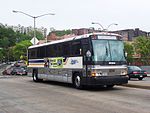
1985 1991 - 96-series introduced in 1985; 102-series introduced in 1986.
- Fluted stainless steel sides.
- First mass-produced 50-state 102 in (2.59 m)-wide coaches by MCI.
- Available with 2 or 3 axles (last digit indicated the number of axles).
- Wheelchair lift-equipped version designated 102AW3.
B series
96B3
102B311 ft (3.35 m) 40 ft (12.19 m) 96 in (2.44 m)
or
102 in (2.59 m)1991 1993 (102B3)
1994 (96B3)- Offered with fluted stainless steel or smooth paintable sides.
- Equipped with destination sign and spiral entry steps.
C series
102C311 ft 6 in (3.51 m)
or
11 ft 9 in (3.58 m)40 ft (12.19 m) 102 in (2.59 m) 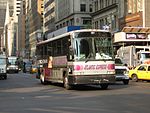
1988 1993 - Last MCI model with a slanted rear cap.
- Front-end design used for the D series.
- Optional stainless steel front-end offered from 1992 onward, and continued on the D series.
D series
102D3
102DL311 ft 5 in (3.48 m) 40 ft 6 in (12.34 m)
or
45 ft 7 in (13.89 m)102 in (2.59 m) 1993 - Also offered with stainless steel front-end.
- Replaced by models D4000 and D4500.
D series narrow
D4000N11 ft 5 in (3.48 m) 40 ft 6 in (12.34 m) 96 in (2.44 m) 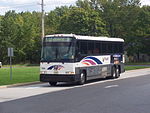
2003 2003 - Only 12 units of this model were produced: 8 for Pace and 4 for NJ Transit.
F series
F350011 ft 1 in (3.38 m) 35 ft 5.5 in (10.81 m) 102 in (2.59 m) 
2000 2003 - Two axle coach based on the DINA Avante.
- Originally designated as model F12 and offered as a conversion shell.
- Last 35-foot buses produced by MCI.
G series
G4100
G450011 ft 6 in (3.51 m) 41 ft 7 in (12.67 m)
or
45 ft 7 in (13.89 m)102 in (2.59 m) 
2000 (G4100)
2001 (G4500)2000 (G4100)
2005 (G4500)- Initially to be designated 102G3 and 102GL3.
- Only 25 pre-production G4100s built.
- Redesigned front-end used on the D series.
MC series (1958–1998)
These models bore the MC-number designation.
Model Height Length Width Photo Introduced Discontinued Notes MC-12 11 ft (3.35 m) 40 ft (12.19 m) 96 in (2.44 m) 
1991 1998 - Built only for Greyhound.
- Similar to the MC-9, but with square headlights.
MC-9 11 ft (3.35 m) 40 ft (12.19 m) 96 in (2.44 m) 
1978 1990 - Also known as the Crusader II
MC-8 10.83 ft (3.30 m) 40 ft (12.19 m) 96 in (2.44 m) 1973 1978 - First MCI built with optional automatic transmissions.
- Also known as the Crusader.
MC-7 10.83 ft (3.30 m) 40 ft (12.19 m) 96 in (2.44 m) 1968 1973 - First 40-foot buses built by MCI.
MC-6 / MCX-6[19] 12 ft (3.66 m) 40 ft (12.19 m) 102 in (2.59 m) 
1969 1970 - Two prototype MC-6Xs produced in 1969.
- Only 12 ft (3.66 m)-high buses produced by MCI. Wider-than-normal coaches not approved to operate in all 50 states.
- Built only for Greyhound.
- Originally powered by GM 12V71 engines. American units later repowered with GM 8V71 engines.
MC-5C 10 ft (3.05 m) 35 ft (10.67 m) 96 in (2.44 m) 1977 1980 - Used MC-8 roof cap.
MC-5B 10 ft (3.05 m) 35 ft (10.67 m) 96 in (2.44 m) 1971 1977 MC-5A / MCC-5A 10 ft (3.05 m) 35 ft (10.67 m) 96 in (2.44 m) 1964 1970 - Early-production Canadian units (to 1965) designated MCC-5A.
MC-5 / MCC-5 / MCX-5 10 ft (3.05 m) 35 ft (10.67 m) 96 in (2.44 m) 1964 1964 - MCX-5 prototype built as Central Greyhound Lines 2400 in December 1962.
- First buses built at MCI's Pembina, ND plant.
- Canadian-built units designated MCC-5.
MC-4 10 ft (3.05 m) 35 ft (10.67 m) 96 in (2.44 m) 1963 1963 MC-3 / MCX-3 10 ft (3.05 m) 35 ft (10.67 m) 96 in (2.44 m) 1961 1963 - MCX-3 prototype built as Thiessen Transportation Ltd. number 24 in December 1961.
MC-2 / MCX-2 10 ft (3.05 m) 35 ft (10.67 m) 96 in (2.44 m) 1960 1961 - MCX-2 prototype built as Pontiac Bus Lines number 6029 in April 1960.
MC-1 / MCX-1 10 ft (3.05 m) 35 ft (10.67 m) 96 in (2.44 m) 1958 1961 - MCX-1 prototype built as Western Canada Greyhound Lines number W1000 in August 1959.
Courier series (pre-1960)
Model Length Image Photo Introduced Discontinued Notes Courier 200B 1949 1949 Courier 200A 1948 1949 Courier 200 1947 1948 Courier 100C 1949 1949 Courier 100B 1948 1949 Courier 100A 1947 1948 Courier 100 1946 1947 Courier 97 1956 1956 Only one built in December as Western Canada Greyhound Lines number W960. Courier 96 1955 1960 Courier 95D 1953 1960 Diesel. Courier 95
Courier 95 Skyview1953 1960 Courier 90
Courier 90 Skyview1953 1960 Courier 85X 1952 1952 Courier 85A 1951 1952 Courier 85 1950 1952 Courier 50 Courier 50A 1950 1955 Transit (all discontinued)
Model Length Width Photo Notes TC40-102A TC40‑102N
Classic40 ft (12.19 m) 102 in (2.59 m) 
- Design acquired from General Motors Diesel Division and built by MCI from 1987 to 1993. Design sold to Nova Bus in 1993.
- Also offered in suburban configuration.
TC60-102N
Classic60 ft (18.29 m) 102 in (2.59 m) 
- Articulated bus.
- Only 9 units built by MCI: 7 for Metro Transit in Halifax, NS and 2 for Réseau de transport de la Capitale in Quebec, PQ.
RTS-06 or −08 30 ft (9.14 m)
or
35 ft (10.67 m)
or
40 ft (12.19 m)96 in (2.44 m)
or
102 in (2.59 m)

- Design acquired from General Motors, and built by MCI (Transportation Manufacturing Corporation) from 1987 to 1994. Sold to Nova Bus in 1994.
- Also offered with WFD (Wide Front Doors) option.
40TRY - Trolleybus. One demonstrator built 1942.
150 - Built circa 1939.
References
- ^ History of Motor Coach Industries. Mcicoach.com. Retrieved on October 17, 2011.
- ^ Company News; Boards Approve Grupo Dina-Motor Coach Merger – New York Times. Nytimes.com (May 19, 1994). Retrieved on October 17, 2011.
- ^ http://www.highbeam.com/doc/1G1-15682844.html
- ^ Industry Today – The World of Manufacturing. Usitoday.com. Retrieved on October 17, 2011.
- ^ Grupo Dina Unveils Its HTQ Series. Theautochannel.com. Retrieved on October 17, 2011.
- ^ Grupo Dina Unveils Its HTQ Series Launching a New Era in Global Truck Technology | Business Wire. Find Articles (September 24, 1998). Retrieved on October 17, 2011.
- ^ History. Dina.com.mx. Retrieved on October 17, 2011.
- ^ INTERNATIONAL BUSINESS; Mexican Truck Maker May Lose Order – New York Times. Nytimes.com (September 28, 2000). Retrieved on October 17, 2011.
- ^ Union Postpones Strike at Grupo Dina Plant. Theautochannel.com. Retrieved on October 17, 2011.
- ^ COMPANY NEWS; GRUPO DINA PLANS TO SELL 61% STAKE IN MOTOR COACH UNIT – New York Times. Nytimes.com (June 16, 1999). Retrieved on October 17, 2011.
- ^ MARKET-LEADING MOTOR COACH & TRUCK MANUFACTURER EXPANDS SYMIX SOFTWARE ACROSS 11-SITE OPERATION. – Free Online Library. Thefreelibrary.com (October 19, 1998). Retrieved on October 17, 2011.
- ^ History. Dina.com.mx. Retrieved on October 17, 2011.
- ^ Presentó Grupo Dina sus Camiones HTQ en Argentina. Truckinginfo.com. Retrieved on October 17, 2011.
- ^ http://www.dimexfreight.com/
- ^ DINA S.A. Maquinas de Compresion de Gases. Compresoresdina.com. Retrieved on October 17, 2011.
- ^ MacPherson, James. Motor Coach files for bankruptcy protection, Grand Forks Herald, September 15, 2008. Accessed September 17, 2008.
- ^ Motor Coach Industries Emerges from Chapter 11. Pr-inside.com. Retrieved on October 17, 2011.
- ^ KPS Capital Partners, LP. Kpsfund.com. Retrieved on October 17, 2011.
- ^ Plachno, Larry (March 1981). "MCI MC-6: The bus that wanted to be Scenicruiser". National Bus Trader (National Bus Trader, Inc.): 12–31.
External links
Crown Corporations Publicly traded corporations Great-West Lifeco · IGM Financial · Buhler Industries · The North West Company · Boyd Autobody · Manitoba Telecom Services · Winpak · New Flyer Industries · Arctic GlacierPrivate corporations Richardson International · Cargill Canada · K-tel · Paterson GlobalFoods · Canad Inns · Palliser Furniture · Motor Coach IndustriesNorth American bus builders Active Eagle Bus
ElDorado National
Federal Coach
Ford Motor Company
Glaval Bus
Gillig Corporation
Girardin Minibus
Goshen CoachIC Bus
Millennium Transit Services
Motor Coach Industries
North American Bus Industries
New Flyer Industries
Nova Bus
Optima Bus Corporation
Orion InternationalPrevost Car
Setra
Stallion Bus Industries
Starcraft Bus
Thomas Built Buses
Trans Tech
Trident Bus IndustriesDefunct ACF-Brill
Aerocoach
AM General
AmTran
Beck
Canadian Car and Foundry
Carpenter Body Company
Corbeil Bus CorporationCrown Coach Corporation
Fageol
Fifth Avenue Bus Company
FitzJohn
Flxible
General Motors Corporation/
General Motors Diesel Division (GM Coach)
KenworthLAG Motorcoach
Mack Trucks
MASA
National Coach Corp.
Neoplan USA
Superior Coach Company
Transportation Manufacturing CorporationTwin Coach
U.S. Bus Corporation
Ward Body Works
Wayne Corporation
Wayne Wheeled Vehicles
White Motor Company
Yellow CoachCategories:- Bus manufacturers
- Companies established in 1932
- Companies based in Cook County, Illinois
- Schaumburg, Illinois
- Companies based in Winnipeg
- Pembina County, North Dakota
- Motor vehicle assembly plants in Canada
- Hybrid electric bus manufacturers
- Private equity portfolio companies
Wikimedia Foundation. 2010.

